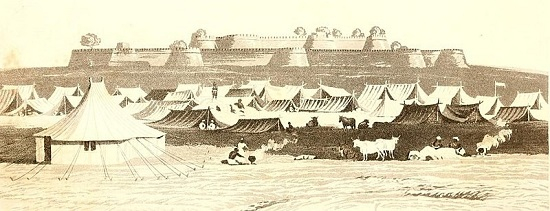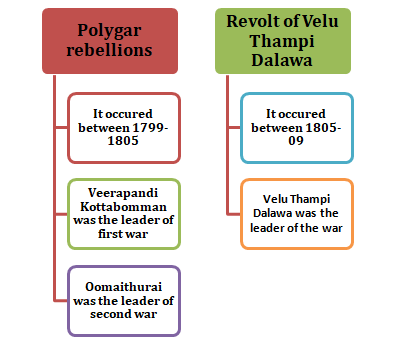

After the Plassey battle of 1757, the whole country was under the dominance of the British, both politically and economically. Because of this incident, the landlords and the chieftains lost much of their power and not only that, but they also lost many of their properties and estates. It resulted in many uprisings against the British, that was the protest by deposed chieftains and landlords.
The poligars or the polygars are also referred to as the Palaiyakkarars, who were from the Tirunelveli Kingdom of South India. Between the years 1799 to 1805, they gave a major fight to the British. At this time two major poligar wars occurred between the poligar and the British government. Madurai, Sivaganga, Sivagiri and Tirunelveli were the most powerful central from where the whole war was controlled.
it was believed that south India's Poligars were similar to north India's Rajputs. They were the military chief who got the lands in exchange for their military services. They have a major influence in terms of powers. The situation changed when the Nawab of Arcot gave control of some places such as Tirunelveli and Carnatic, to the British government.

Figure 1: Two revolts and the timeline
It caused the main problem among the Poligars because they were the independent authority in their territories. As a result of this situation, two poligar wars took place. In 1799, the first war broke out and this revolt was led by Veerapandi Kottabomman. He refused to accept the British and stand against paying the revenue to them. He had defied for 7 years and in the end, the government to set an example of warning to the other poligars hanged him publicly.

Figure 2: View of Comery- Polygars
Artist: James Welsh (1775–1861); Engraver: Robert Havell, Jr., Public domain, via Wikimedia Commons
The second war broke out after the British government suppressed the first one. It was also known as the South Indian Rebellion, because of the range and impacts of the war. Because of it, the second war was more violent in form and it started in February of the year 1801. This war was controlled by the brother of Veerapandi Kottabomman, Oomaithurai, who was able to take the control of many forts and even successfully captured Tuticorin.
In the year 1801 the nawab of Arcot signed a treaty with the British government and it was named the Carnatic treaty. Under this treaty, he surrendered all the civil and military administration that comes under his territories to the British. Because Poligar system brutally came to an end. In replacement of it, the British government implemented the zamindari settlement in the place.
Thampi Chempakaraman Velayudhan led one of the major revolts against the British. He was popular as Velu Thampi and he was the Dalawa, which means the Prime minister, of the Travancore kingdom. In the year, 1805 he started the revolt against the ruler because the government tried to throw him out of the position of Diwan. Not only that, but they also tried to impose an excessive financial burden on the people. He stands against the imposed burden on the kingdom, which was imposed by the Subsidiary Alliance Treaty. This treaty was signed forcefully by Travancore in the year 1805 and as a result of the treaty, the number of British troops increased drastically.
At the same time, the kingdom started facing a major financial crisis because of the extra expenses.
Under the treaty, the British also started interfering with the internal situations of the kingdom. He was able to gather major support from the people of his kingdom and outside of the country against British rule. Velu Thampi managed to arrange armed forces against British rule and prepared for a long war. The battle of Quilon ended in the years 1809. At the end of the battle, the force of Thampi lost against the British force and as a result, they ordered to capture and execute him in public to set an example for the rest of the people. However, in 1809, Velu Thampi fled and he took his own life to avoid the capturing.
These two uprisings led by Velu Thampi Dalawa and Veerapandi Kottabomman left a huge impact on the history of India. They both are examples of unsuccessful attempts at wars but gave a fight against British colonialism. They occurred in the most politically, economically and socially disrupted condition when the landlords and chieftains faced major problems. These two revolts are considered the earliest freedom struggles that were conducted from 1799 to 1809 and this was the time when the British entrenched themselves in this country.
Q1. Who was the leader of the Ramosi tribal revolt of 1882?
In the year 1882, Chittur Singh led the Ramosi tribal revolt. It was also known as the Ramosi uprising, and it took place against the new pattern of administration planned by the British. It is considered the first tribal uprising against the government run by the British.
Q2. What was the major revolt by the Indians against the British government?
The first widely spread revolt was the Indian Mutiny. It was begun by the Indian troops who worked under the British East India Company and it began from Meerut and spread to Lucknow, Kanpur and even Delhi.
Q3. What was the main reason behind the tribal revolts?
There were many tribal revolts against the government run by the British in the 19th century. Most of those uprisings had the same cause; they were against the “land settlement and land laws”. It created major tension among the tribal community because non-tribal groups started entering the forest.
Q4. What is the Khasi uprising?
The Khasi uprising occurred in the Hills of Khasi and Jaintia in the year 1833.